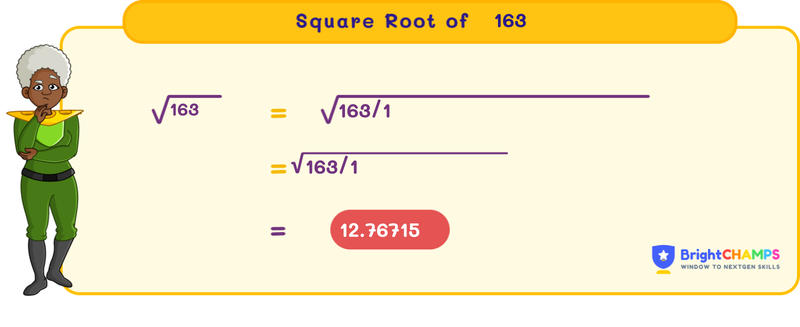
 164 Learners
164 LearnersLast updated on May 26th, 2025

Square Root of 163

If a number is multiplied by the same number, the result is a square. The inverse of the square is a square root. The square root is used in fields such as vehicle design, finance, etc. Here, we will discuss the square root of 163.
What is the Square Root of 163?
The square root is the inverse of the square of the number. 163 is not a perfect square. The square root of 163 is expressed in both radical and exponential form. In the radical form, it is expressed as √163, whereas (163)(1/2) in the exponential form. √163 ≈ 12.7671, which is an irrational number because it cannot be expressed in the form of p/q, where p and q are integers and q ≠ 0.

Struggling with Math?
Get 1:1 Coaching to Boost Grades Fast !

Finding the Square Root of 163
The prime factorization method is used for perfect square numbers. However, for non-perfect square numbers such as 163, we use methods like the long-division method and the approximation method. Let us now learn the following methods:
- Prime factorization method
- Long division method
- Approximation method
Square Root of 163 by Prime Factorization Method
The product of prime factors is the prime factorization of a number. Now let us look at how 163 is broken down into its prime factors:
Step 1: Finding the prime factors of 163 Since 163 is a prime number itself, it cannot be broken down further into other prime factors.
Step 2: Since 163 is not a perfect square and is already a prime number, calculating its square root using prime factorization is not applicable.
Square Root of 163 by Long Division Method
The long division method is particularly used for non-perfect square numbers. Let us now learn how to find the square root using the long division method, step by step.
Step 1: To begin with, we need to group the numbers from right to left. In the case of 163, we need to consider it as 16 and 3.
Step 2: Find n whose square is less than or equal to 16. We can say n is '4' because 4 x 4 = 16. Now the quotient is 4, and after subtracting 16 - 16, the remainder is 0.
Step 3: Bring down the next pair, which is 3, making the new dividend 3. Add the old divisor with itself, 4 + 4, to get 8 as the new divisor.
Step 4: Determine n such that 8n x n is less than or equal to 300 (since we consider two decimal places, the new dividend is 300 after adding zeroes).
Step 5: Suppose n = 3, then 83 x 3 = 249.
Step 6: Subtract 249 from 300 to get 51. The quotient now becomes 12.7 (approx).
Step 7: Continue these steps until you reach the desired number of decimal places. The square root of √163 ≈ 12.7671.
Square Root of 163 by Approximation Method
The approximation method is another way to find the square roots. It is an easy method to find the square root of a given number. Let's learn how to find the square root of 163 using the approximation method.
Step 1: Identify the closest perfect squares around √163. The closest perfect squares to 163 are 144 (122) and 169 (132). √163 falls between 12 and 13.
Step 2: Use linear approximation to find the decimal part: (163 - 144)/(169 - 144) = 19/25 = 0.76
Add this decimal to the lower perfect square root: 12 + 0.76 = 12.76
Thus, the square root of 163 is approximately 12.76.

Common Mistakes and How to Avoid Them in the Square Root of 163
Students often make mistakes while finding the square root, such as forgetting about the negative square root and skipping steps in the long division method. Let's look at a few common errors in detail.
Level Up with a Math Certification!
2X Faster Learning (Grades 1-12)


Square Root of 163 Examples

Problem 1
Can you help Max find the area of a square box if its side length is given as √163?

The area of the square is approximately 163 square units.
Explanation
The area of the square = side2.
The side length is given as √163.
Area of the square = (√163)2 = 163.
Therefore, the area of the square box is approximately 163 square units.

Problem 2
A square-shaped building measuring 163 square feet is built; if each of the sides is √163, what will be the square feet of half of the building?

81.5 square feet
Explanation
Since the building is square-shaped, dividing the total area by 2 gives half the area.
Dividing 163 by 2 = 81.5.
So half of the building measures 81.5 square feet.

Problem 3
Calculate √163 x 5.

63.8355
Explanation
First, find the square root of 163, which is approximately 12.7671.
Then multiply 12.7671 by 5.
So 12.7671 x 5 ≈ 63.8355.

Problem 4
What will be the square root of (153 + 10)?

The square root is 13.
Explanation
To find the square root, calculate the sum of (153 + 10).
153 + 10 = 163, and then √163 ≈ 12.7671.
Therefore, the square root of (153 + 10) is approximately ±12.7671.

Problem 5
Find the perimeter of the rectangle if its length ‘l’ is √163 units and the width ‘w’ is 38 units.

The perimeter of the rectangle is approximately 101.5342 units.
Explanation
Perimeter of the rectangle = 2 × (length + width)
Perimeter = 2 × (√163 + 38)
≈ 2 × (12.7671 + 38)
≈ 2 × 50.7671
≈ 101.5342 units.

Turn your child into a math star!
#1 Math Hack Schools Won't Teach!


FAQ on Square Root of 163
1.What is √163 in its simplest form?
2.Is 163 a prime number?
3.Calculate the square of 163.
4.What are the factors of 163?
5.Is 163 divisible by any number other than 1 and itself?
6.How does learning Algebra help students in Qatar make better decisions in daily life?
7.How can cultural or local activities in Qatar support learning Algebra topics such as Square Root of 163?
8.How do technology and digital tools in Qatar support learning Algebra and Square Root of 163?
9.Does learning Algebra support future career opportunities for students in Qatar?
Struggling with Math?
Get 1:1 Coaching to Boost Grades Fast !

Important Glossaries for the Square Root of 163
- Square root: The operation of finding a number that, when multiplied by itself, gives the original number. For example, the square root of 16 is 4, since 4 x 4 = 16.
- Irrational number: A number that cannot be expressed as a simple fraction; it has a non-repeating, non-terminating decimal expansion. For example, the square root of 163 is irrational.
- Prime number: A natural number greater than 1 that has no positive divisors other than 1 and itself. For example, 163 is a prime number.
- Radical expression: An expression that includes a square root, cube root, etc. For example, √163 is a radical expression.
- Approximation: The process of finding a value that is close enough to the right answer, usually with some understanding of the error involved. For example, √163 ≈ 12.7671 is an approximation.
Explore More algebra
![Important Math Links Icon]() Previous to Square Root of 163
Previous to Square Root of 163
About BrightChamps in Qatar


Jaskaran Singh Saluja
About the Author
Jaskaran Singh Saluja is a math wizard with nearly three years of experience as a math teacher. His expertise is in algebra, so he can make algebra classes interesting by turning tricky equations into simple puzzles.
Fun Fact
: He loves to play the quiz with kids through algebra to make kids love it.




